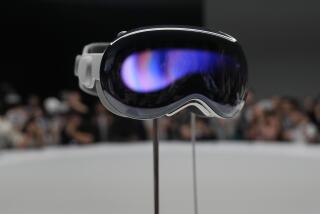TV makers hope viewers will embrace 3-D-enabled sets
Will 2010 finally be the year that 3-D comes to home television?
After decades of eyestrain and nausea-producing experiments that involved flimsy glasses from cereal boxes, a grown-up version of living room 3-D might finally be ready.
FOR THE RECORD:
3-D television: An article in Business on Sunday about new technology making home versions of the 3-D format viable said that moviegoers watching 3-D films in the 1950s were issued color-tint glasses. The 3-D glasses of that era generally used polarized lenses to create the depth effect. —
This week at the huge Consumer Electronics Show in Las Vegas, several of the big guns in TV manufacturing -- Sony, Panasonic and Vizio, to name a few -- will be showcasing 3-D-enabled sets and other gear that they hope viewers will embrace.
It’s especially important to the industry now that the novelty of flat screens is wearing off for consumers and retail prices are falling so rapidly that the profit on TVs is nearing that of toasters.
The TV world needs fresh technological meat.
“Their existing sets are not broken,” Panasonic Corp. Executive Vice President Bob Perry said. “Constant technological change over the years . . . has given consumers the reason to buy.”
There have been some promising signs that 3-D could provide that reason.
* Some recent movies issued in 3-D did big business in theaters, including “Up” and the current blockbuster “Avatar.”
* Last month a Blu-ray standard was finalized that could make it practical for 3-D movies to be issued on the high-resolution disks for home use. That could greatly improve picture quality and, hopefully, make it a far better experience for the viewer than with past experiments.
* A satellite TV provider, Sky TV in Europe, announced that it would launch a 3-D channel this year.
The technology has finally arrived -- high-definition TV and innovations in 3-D have made home versions of the format viable.
But whether the masses are ready to embrace 3-D -- and the glasses required to view the format -- remains to be seen. Football fans attending last month’s game between the Dallas Cowboys and San Diego Chargers gave the technology a smackdown.
Cowboys Stadium in Arlington, Texas, boasts a gigantic high-definition video screen hovering over the field. The plan was to allow ticket holders to watch close-ups and replays in 3-D during the second half with the help of special specs distributed to the crowd of about 80,000.
Except that they hated it. The experiment lasted less than seven minutes after the stadium erupted in boos.
“Not everyone wanted to wear the glasses,” said analyst Paul Gagnon of market researcher DisplaySearch. “And if you didn’t, the screen was all blurry. It looked terrible.”
The Cowboys Stadium debacle showed the challenges facing manufacturers to make the 3-D experience work outside insulated, controlled conditions, like those in a movie theater. A typical living room may not feature thousands of inebriated fans, but it has plenty of its own distractions: trips to the bathroom, restless children (who will need their own 3-D glasses), ringing cellphones and the pizza guy at the door. Can 3-D survive multi-tasking?
“If any analyst tells you, ‘Absolutely, we know people are going to be taking this into their homes,’ we would be lying,” said analyst Richard Doherty of the Envisioneering Group, a technology consulting firm. “No one really knows that.”
What’s clear is that manufacturers are plunging ahead, with most announcements to come at the Consumer Electronics Show. LG Electronics Inc. in South Korea jumped the gun last month by saying it planned to make and sell 40,000 3-D-enabled TVs in 2010. Tim Alessi, head of new product development for LG’s U.S. division, wouldn’t comment on the announcement except to say that the company planned to have some of those sets on the market in this country.
Japan’s Panasonic has been the most active among major consumer electronics companies in promoting 3-D TV. It also played a major role in developing the 3-D Blu-ray standard that will allow high-definition televisions to show the format in far greater resolution than previously possible.
Price, of course, will be a factor for consumers deciding whether to get a 3-D-enabled TV. New technology can cost big.
“When we went from analog to digital,” Perry of Panasonic said, “sets were five times more expensive. . . . But the introduction of 3-D will not nearly be that.”
At the Consumer Electronics Show, manufacturers are likely to reveal their prices for their sets, as well as for their 3-D-enabled Blu-ray players.
“Our running assumption is that the cost premium should be pretty reasonable -- 10% or less,” analyst Gagnon said.
The 3-D glasses might not be included in the sets. None of the manufacturers would say yet if the glasses will come bundled or will be a la carte.
One thing for sure is that they won’t be the cardboard, red-blue tint glasses that audiences in the 1950s used to watch 3-D movies such as “Bwana Devil” (which advertised: “A lion in your lap! A lover in your arms!”), “House of Wax” and Alfred Hitchcock’s “Dial M for Murder.” Glasses are now much sturdier, less dorky and more expensive. Analysts say they might cost as much as $100 a pair if not bundled with a TV, depending on the technology used.
“If you buy six pairs to have a crowd over to watch a show,” Gagnon said, “that can get very expensive.”
One of the major glasses manufacturers, RealD in Beverly Hills, has announced deals with Sony and JVC to provide the gear for their 3-D-enabled sets. It’s not clear whether these will be polarized glasses, like those used in most 3-D-equipped movie theaters, or the more costly glasses that use a battery-operated shutter system to open and close the lenses so fast that the movement can’t be perceived.
Some companies are experimenting with 3-D technology that doesn’t require glasses. But that has major limitations too. Dutch company Royal Philips Electronics, for example, has been demonstrating a prototype that requires viewers to adjust their heads to just the right spot for the effect to work.
“You move to the sweetest view,” analyst Doherty said.
That could lose its charm quickly.
Unless there’s a secret project somewhere that’s close to a breakthrough in 3-D without glasses, that technology is probably a long way off.
“There won’t be non-glasses 3-D for at least another 10, 15 years,” Perry said.
For the foreseeable future, manufacturers will have to sell 3-D as being cool, even with the eyewear.
If 3-D TV does provide a viable profit center, it would buck a 3-D trend. In the 1950s, for example, Warner Bros. was so convinced that 3-D would save the movies from the competition of television that cartoon director Chuck Jones quipped that studio chief Jack Warner believed humans would evolve to the point where “they would be born with one red and one blue eye.”
But 3-D remained a novelty until the recent string of hits in the format.
“There is a resurgence of interest every few decades in 3-D,” Gagnon said. “This is just the latest iteration of it.”
And this time it might take hold in the living room, even as early as this year. Gagnon recalled that in 2007, when the first HDTV sets in the highest resolution -- 1080p -- became generally available, consumers took to them even though there wasn’t much commercial content available in that visual quality.
“But we had a lot of people buying sets capable of showing 1080p so that they would be future proof,” Gagnon said.
Even so, he cautions that the 3-D home technology probably won’t be an immediate boom. “This is really for the long run,” Gagnon said. “Not just in 2010, but 2011 and 2012. It will be baby steps.”
More to Read
The biggest entertainment stories
Get our big stories about Hollywood, film, television, music, arts, culture and more right in your inbox as soon as they publish.
You may occasionally receive promotional content from the Los Angeles Times.











